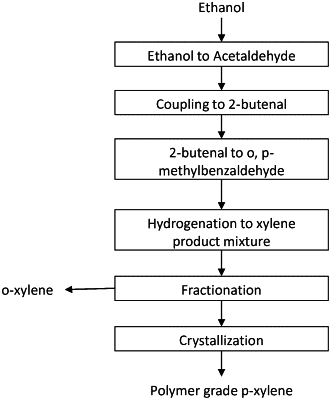| CPC C07C 1/2076 (2013.01) [C07C 7/04 (2013.01); C07C 45/68 (2013.01); C07C 2521/04 (2013.01); C07C 2521/06 (2013.01); C07C 2521/18 (2013.01); C07C 2523/44 (2013.01); C07C 2523/656 (2013.01)] | 21 Claims |

|
1. An apparatus for producing p-xylene, comprising:
a gas fermentation bioreactor housing a C1-fixing bacteria to produce ethanol in fluid communication with an oxidation reactor housing an oxidation catalyst to convert the ethanol to acetaldehyde;
the oxidation reactor in fluid communication with a dimerization reactor comprising a dimerization catalyst to convert the acetaldehyde to 2-butenal;
the dimerization reactor in fluid communication with a cyclization reactor comprising a cyclization catalyst to convert the 2-butenal to o-methylbenzaldehyde and/or p-methylbenzaldehyde;
the cyclization reactor in fluid communication with a hydrogenation reactor comprising a hydrogenation catalyst to convert the o-methylbenzaldehyde and/or p-methylbenzaldehyde to saturated cyclic compounds and non-equilibrium mixture of xylenes;
the hydrogenation reactor in fluid communication with a first fractionation zone that separates the saturated cyclic compounds from the non-equilibrium mixture of xylenes;
the first fractionation zone in fluid communication with a second fractionation zone that separates o-xylene from the non-equilibrium mixture of xylenes; and
the second fractionation zone in fluid communication with a first crystallizer that separates p-xylene from the non-equilibrium mixture of xylenes.
|